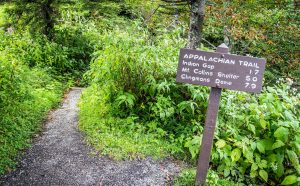
Courtesy image
Commonly known simply as the A.T., here are some Appalachian Trail facts to help you celebrate this amazing stretch of the East Coast
The Appalachian Trail, which stretches just shy of 2,200 miles from Springer Mountain, Georgia, to Mount Katahdin, Maine, is the most iconic trail in the United States. More commonly known simply as the A.T., this amazing stretch of East Coast wilderness is marked by roughly 165,000 white blazes and includes a variety of lowland and steep terrain, mostly made up of dirt, grassy or rocky paths. It’s been the focus of countless books, movies and other media, and with a deep history dating to its conception soon after World War I and its completion in 1937, there are no shortage of interesting Appalachian Trail facts to discover.

Here are 13 Appalachian Trail facts that every die-hard hiker should know:
- The Appalachian National Scenic Trail (as it is now formally known) was first envisioned by Benton MacKaye of Massachusetts and was in the planning and building stages through much of the 1920s and ’30s.
- The popularity of the Appalachian Trail didn’t really take off until the late 1960s, and today, according to the nonprofit Appalachian Trail Conservancy, more than 3 million people visit at least a portion of the trail every year.
- About 99 percent of the trail currently passes through public lands, and it is managed by the National Park Service, U.S. Forest Service, and the Appalachian Trail Conservancy. It also has dozens of local maintenance clubs involved in its upkeep, making it the largest and longest running volunteer conservation project in the world.
- Unlike some of its well-known cousins (such as the Pacific Crest Trail), the A.T. doesn’t allow any kind of pack animals on it, making it the longest hiker-only trail in the nation.
- The trail passes through 14 states: Georgia, North Carolina, Tennessee, Virginia, West Virginia, Maryland, Pennsylvania, New Jersey, New York, Connecticut, Massachusetts, Vermont, New Hampshire, and Maine. It’s notable for not having specified entry points or gates, but rather can be accessed from a wide variety of locations in each state.
- Virginia is the state featuring the largest stretch of the Appalachian Trail, totaling 554 miles. In Shenandoah National Park, you can cross the A.T. more than 30 times without getting out of your car.

- More than 3,000 people attempt to thru-hike the trail each year, meaning they strive to hike the entire length, usually starting in Georgia in the spring and ending in Maine later in the year. Most thru-hikes take five to seven months to complete, and typically, only a quarter of those who set out on the arduous journey actually make it. The first thru-hike, according to History, was done in 1948 by World War II veteran Earl Shaffer, who decided it would be ideal for walking “the Army out of my system.” Shaffer hiked the full trail twice more, including in 1998 at age 79.
- The fastest known time to thru-hike the A.T. was completed by Karel Sabbe, a Belgian dentist, on Aug. 29, 2018, in a time of 41 days, seven hours and 39 minutes. His was a supported hike, which means he traveled particularly light and had a team helping him along the way with food, shelter and other amenities. The fastest unsupported thru-hike was completed the previous year, in 2017, by Joe McConaughy, who went by the trail name Stringbean. He finished in 45 days, 12 hours and 15 minutes.
- If you hiked the full length of the Appalachian Trail today, the odds are that you wouldn’t overlap much of the same ground your ancestors did — the trail has been rebuilt or changed significantly since its completion.
- While the first paragraph of this article mentioned the trail’s wilderness, the reality is that trail is frequently located relatively close to civilization, with scores of small mountain communities built into the Appalachians. The trail is very well marked, but maps (like the ones National Geographic publishes), a quality orienteering compass and a GPS device are recommended for section hikers and thru-hikers.
- Clingmans Dome in Great Smoky Mountains National Park is the highest point on the trail, sitting at 6,643 feet above sea level.
- The Appalachians might not have the pointed peaks or snow caps associated with the Rockies, but don’t assume that the A.T. is a cake walk. Thru-hikers gain and lose over 464,464 feet of elevation, or more than 89 miles, during the duration of the trail.
- You’re forgiven if you hear folks talking about the Blue Ridge, or the Smokies or the Adirondacks and get a little confused while planning for a hike. These are just names of provinces or subranges that contribute to the greater Appalachian Mountains.

 Your Privacy Choices
Your Privacy Choices